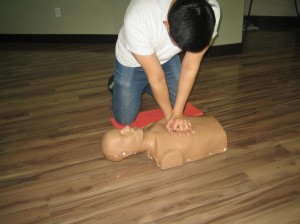Overview Of CPR
CPR can significantly increase the survival of a casualty who is experiencing cardiac arrest. If more individuals knew how to carry out CPR, more casualties would survive. By studying this useful first aid method, you may be able to save somebody you know or a stranger who requires immediate assistance.
Defining CPR
-
Save A Life And Perform CPR CPR is a process in which a casualty’s heart or breathing is started by physically compressing the casualty’s chest and forcing air into the lungs by breathing into the mouth.
- When a casualty experiences cardiac arrest (the heart ceases to beat) or they stop breathing, execute CPR right away to increase the casualty’s possibility of survival.
- The reasons for cardiac arrest include an interruption in heart rhythm, poisoning/drugs, severe injury, or anaphylaxis (shock).
- The function of CPR is to keep the blood flowing so it can keep the vital organs active. CPR can keep a casualty alive while you are waiting for a defibrillator to arrive. A defibrillator transmits an electrical shock to the heart to revive it.
Various Types of CPR Methods
- The two types of CPR are either by mouth-to-mouth resuscitation or by providing chest compressions.
- Mouth-to-mouth resuscitation transmits air into the lungs of the casualty when an individual inhales. Even though you are blowing into the casualty’s lungs, your breath still holds sufficient oxygen to help the casualty to begin breathing again.
- By performing compressions, you help to keep the blood flowing within the body. When a casualty’s heart stops beating, chest compressions will keep the blood flowing.
Defining Bystander Reluctance
- When somebody experiences cardiac arrest in an open area, he or she relies on bystanders till medical assistance gets there.
- Even if bystanders are familiar with CPR, they might be unwilling to do it.
- They might fear getting an infection or be anxious about executing CPR correctly. If you are familiar with CPR and you are an onlooker in an incident where a person needs first aid, it is vital to remain calm.
- Relax and take a deep breath, and briefly go over the procedures in your mind. Then, steadily carry out CPR on the casualty.

